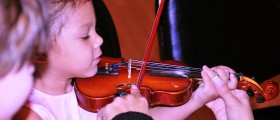
Most people enjoy music and have their own favorite subtypes of this interesting and vivid art. Music is known to have a positive impact on us, making us happier and relaxed. However, music can also motivate us to feel anger or even sadness, depending on the tones we get exposed to and the emotions these tones are capable of evoking.
Due to the fact that music has this amount of power over us, people have developed ways which allow them to use music in order to help those who are experiencing certain health problems. Namely, music therapy is the name of a health profession created for these purposes.
Definition
Basically, music therapy is a form of treatment where a trained professional in this area of science uses music and all the factors related to its power, including the emotional, mental, social, aesthetic, spiritual and many other elements, in order to boost one's health and his/her overall well-being.
As far as the effect music can have on a person is concerned, it can boost one's cognitive functioning or his/her motor skills, emotional progress, social and behavioral skills, along with the general quality of a person's life.
The music used in this therapy involves singing, songwriting, dancing, discussing and listening, among other things, depending on the purpose of the therapy in the first place. Music therapists are well educated in the fields of psychological theories too and this allows them to combine music with all the necessary therapeutic techniques needed to help a person with emotional or behavioral problems.
Music Therapy for Children
As you have probably guessed, there is a specific branch of music therapy, being directed towards children specifically. This kind of therapy can manifest through group or one-on-one sessions. Initially, when the therapist and the child meet for the first time, they develop the goals of the therapy.
Speaking of the therapy, it takes place in an environment which makes the child feel relaxed and secure. Nevertheless, the area is supposed to be a place which is predominantly created for enjoying music and getting exposed to it, without being affected by some other, distracting factors. The room temperature should be pleasant and the lighting needs to be clear.
Keep in mind that some children involved in the therapy can be disabled or in a wheelchair. Thus, make sure the room doors are easily accessible. The room needs to contain many different instruments from various countries. In order to make these more interesting, you can color the instruments in lively designs. Yet, bear in mind that, while some children may know how to play an instrument, others may only damage it. Thus, be careful about that and keep the high-quality, delicate instruments safe.
Adolescents and older children can be more easily interested in music than younger kids. Basically, an average adolescent listens to music about 4.5 hours each day. Thus, music is a very important factor of their lives and their developing identities. Hence, music therapy can be quite successful with adolescents, even though it rarely fails to help younger children too.
Treatment Techniques
There are two pairs of different techniques which are contrasted in music therapy. Namely, active vs. receptive and improvisational vs. structured are these techniques. For examples, during adolescent music therapy, the boys and girls are exposed to a specific type of music and are allowed to discuss the music and the effect it has on them by improvising and allowing their creativity to form their opinions. Nevertheless, music therapy needs to be carefully planned in order to work, since every person is a unique individual.
All in all, music therapy can indicate emotional and behavioral problems in people and help them battle these issues, regardless whether the obstacles lie in lack of self-esteem or some other difficulties. The body language of the patients, along with their demeanor, mood and attention, all reveal the effect music has on them.
Various researches have proven the value of music therapy. For example, in 2004, Gold, Voracek and Wilgram, took previous studies, made from 1970 to 1998, into consideration, examining the effect of music therapy on children and adolescents who suffered from certain forms of psychopathology. As a result, they found out that music therapy has a significant, medium to large effect on the relevant outcomes.
Furthermore, Nyak and others proved that music therapy affects different parts of the patients' brains, being capable of decreasing depression, improving the overall mood and reducing anxiety. Moreover, the same study proved that people who are exposed to music therapy, combining it with regular therapy for emotional and behavioral problems, have an even greater effect achieved. Music therapy can boost one's social skills and, according to yet another study, this decreases a person's chances of suffering from a stroke, and helps him/her recover from a survived one too.
To sum up, music has a power which affects us strongly. Thus, just as we can get in a better mood when we listen to our favorite song which makes us happy, we can overcome more serious emotional and behavioral problems while undergoing a well-designed music therapy, carried out by trained and experienced professionals.

















Your thoughts on this
Loading...